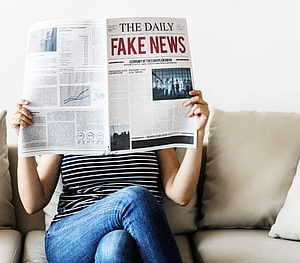Editor’s Note: For another viewpoint, see The Press Has Taken the Trump Bait
As social media outlets have become more proactive in eliminating fake news, including tweets by President Trump, many have criticized these measures.
This isn’t a reflection of any technical design error by the social media companies — it’s because there is a latent demand for fake news that many critics fail to understand.
Like any commodity, two basic factors drive fake news: demand and supply. Starting with the demand side, one may ask why anyone would consciously seek false information. There are two reasons.
The first is purely strategic. If people know that a piece of information is false, but if it supports their interests, and if there’s a chance that someone who doesn’t support those interests reads the false information and is convinced, then it serves a useful purpose in their eyes. In wars, for example, adversaries can benefit from circulating false narratives about each other to garner support.
The second reflects a cognitive flaw in humans, known as confirmation bias: We seek information that supports our prior personal beliefs. Even if people know that a piece of news is false, they are sometimes willing to overlook the falsehood because of the psychological comfort we get from believing it. Think of terminally ill patients hoping for a miracle cure and refusing to acknowledge objective scientific evidence.
This is why there’s significant resistance to the elimination of fake news. The error made by many intellectuals is that they presume that everyone wants to know the truth, and that a technical solution can get rid of the false news. In fact, many people want fake news, both for themselves and for others.
Moreover, even if people were to agree that a world with no fake news is better than one with both beneficial (from their perspective) and adverse fake news, they don’t likely trust governments and/or those who control the media to resolve the issue.
In many western countries, even some heads of state have been accused of maliciously peddling fake news, and a large percentage of the population (often the intellectuals) rejects any effort by those leaders to eliminate fake news.
Similarly, the masses reject efforts by either civil service technocrats or media leaders to eliminate fake news because they suspect that such individuals suffer from a pro-elite, anti-proletariat bias. Thus, nobody has so far proposed a consensual system for identifying and eliminating fake news.
These problems aren’t new; a latent demand for fake news, be it strategic or psychological, is as old as humans. What’s new now is the supply side.
Today, with the advent of social media, smartphones and the advertising-revenue models of Google and Facebook, producing fake news is both cheap and highly lucrative.
Creating “clickbait” has become a full-time pursuit for dedicated fake news experts. Do they care if something is true, disruptive or seditious? If it generates clicks, it generates a lot of money. Prior to the 20th century, mass media was restricted to a narrow elite, and there were large startup costs associated with reaching millions of people. Today, with a $100 smartphone and a free Twitter account, you can be rich in a few weeks by generating fake news.
The COVID-19 crisis has exposed all of these forces: Some people have an interest in using fake news to spread theories about coronavirus’ origins, while others gain psychological comfort from believing that masks either do (or do not) affect transmission.
There are too many conflicts of interest for “fake news regulators” to be considered credible by the entire population, so there’s money to be made for unscrupulous marketers with an expertise in clickbait content.
All that said, the fact that we can rationalize the existence of fake news doesn’t mean that it’s a good thing societally. As the COVID-19 pandemic has demonstrated, fake news proliferation can be lethal.
However, those who wring their hands and demand centralized actions to eliminate falsehoods must start with a realistic and scientific understanding of the phenomenon.
Too often, their actions seem more consistent with the view that their news is real, other people’s news is fake, and that those other people would want the truth if only someone could reliably deliver it to them.
As John Lennon once quipped: “I believe in everything until it’s disproved. So I believe in fairies, the myths, dragons. It all exists, even if it’s in your mind. Who’s to say that dreams and nightmares aren’t as real as the here and now?”

